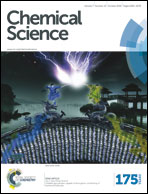Electrocatalytic amplification of DNA-modified nanoparticle collisions via enzymatic digestion†
Abstract
We report a new and general approach that will be useful for adapting the method of electrocatalytic amplification (ECA) to biosensing applications. In ECA, individual collisions of catalytic nanoparticles with a noncatalytic electrode surface lead to bursts of current. In the work described here, the current arises from catalytic electrooxidation of N2H4 at the surface of platinum nanoparticles (PtNPs). The problem with using ECA for biosensing applications heretofore, is that it is necessary to immobilize a receptor, such as DNA (as in the case here) or an antibody on the PtNP surface. This inactivates the colliding NP, however, and leads to very small collision signatures. In the present article, we show that single-stranded DNA (ssDNA) present on the PtNP surface can be detected by selectively removing a fraction of the ssDNA using the enzyme Exonuclease I (Exo I). About half of the current associated with collisions of naked PtNPs can be recovered from fully passivated PtNPs after exposure to Exo I. Experiments carried out using both Au and Hg ultramicroelectrodes reveal some mechanistic aspects of the collision process before and after treatment of the ssDNA-modified PtNPs with Exo I.


 Please wait while we load your content...
Please wait while we load your content...